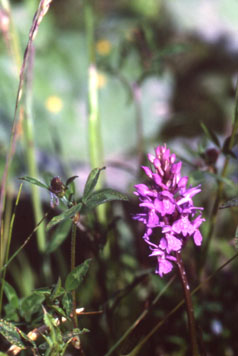 Wild Orchid (Site of John Pit) |
Wigan has a rich heritage buried under a relatively brief period of intense grimy industrial activity based on the twin spoilers of cotton and coal.
In Medieval times Wigan was a pleasant town of local importance as one of the four ancient boroughs of Lancashire.
In 1788 it was a spa town - yes, people came to Wigan to "take the waters".
The underlying rich coal seams and the power of the fast flowing River Douglas led to increased prosperity but at great social cost.
Burgess plots were infilled with crowded, insanitary housing built to take the great influx of incomers, who were hoping to prosper in the new industrial age. Mills mushroomed along the banks of the Douglas and large areas of countryside were buried under vast mining enterprises and their associated spoil heaps and railway systems. Increased use of steam power polluted the atmosphere to an extent that is difficult for us now to imagine.
This intensely polluting age is over and Wigan is looking forward to a new era.
Interestingly almost 70% of the borough is open land. Old colliery sites have been converted to nature reserves and, in one case, a motor sport arena. Their railway systems are now pleasant pathways. The potentially horrendous effects of mining subsidence have in fact created the "Wigan Flashes" - flooded areas of importance to wild life. Nearby Pennington Flash is especially important for wild fowl. Surprisingly, there are four SSSI's (Sites of Special Scientific Interest) located within the borough.
Many mill buildings still stand. Several are used as warehouses. The Trencherfield Mill is part of the Wigan Pier Heritage complex and houses a large working steam engine, a display of textile machinery and the impressive Opie Collection.
The History Shop in Rodney Street has an art gallery, a small museum and an excellent local and family history research area.
For opinions of Wigan past and present click here.
To read more about "Wigan Spa" click here.